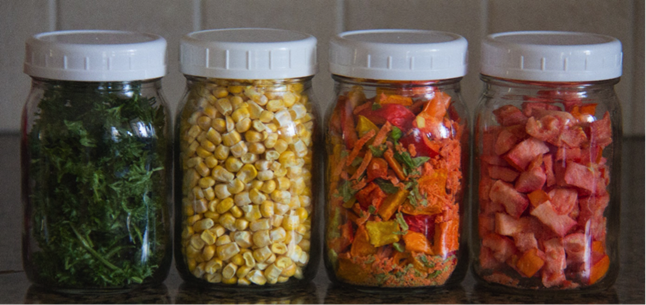My Freeze-Drying Adventures

By Wendy Busse, RD | June 21, 2018
I have been keenly interested in food preservation and making “ready-to-go-meals” for as long as I can remember. Both personally and professionally, I was a strong advocate for freezing meals, dehydrating and vacuum sealing. When I heard about home freeze-dryers that combine all three, I had to have one. The first step was convincing my family that I needed to purchase another kitchen appliance! I have been freeze drying for a few months, and it has been a steep learning curve, but a lot of fun.
How home freeze dryers work
Commercial freeze dryers have been around for a long time, but home freezer dryers have only been available for the last few years. The food is frozen and then warmed under vacuum pressure which sublimates the water. The volume does not change, but the freeze-dried food is light and airy. Bacteria and mold do not grow without water, so the food can be stored at room temperature (if protected from oxygen and moisture).
How I got started
When working with clients, I always suggest starting with small goals. I got my freeze dryer and did not listen to my own advice! My first goal was to freeze-dry individual ingredients and combine them into different soups (cooked ground chicken and beef, cooked beef and chicken cubes, barley, chickpeas, black beans, corn, julienned carrots, diced onions, celery, green and colored peppers). It was a lot of work, but I was able to make several tasty soups by simmering the freeze-dried ingredients with broth and a few spices. This success was energizing and I charged ahead with sauces - starting with pesto sauce. I learned the hard way that oils (and foods that separate into oils) explode in the freeze dryer.
An interesting insight has been the joy of doing repetitive tasks. For the most part, we have lost this in our multi-tasking, modern world. The other day, I washed and chopped fifteen pounds of tomatoes to freeze dry. It took ninety minutes, but it was very grounding to do a repetitive, manual task for that long. I vacuum seal the freeze-dried food in large canning jars. Looking at the brightly colored jars in the cupboard is very rewarding in a nostalgic way.
How freeze drying has changed my cooking, meal planning and eating habits
Freeze drying has changed my day-to- day meal planning. Previously, I cooked large quantities to freeze. That worked well - but I had trouble keeping track of what was in my freezer. I once defrosted some “mystery meat” for supper, only to discover that it was applesauce! Thank goodness my kids were young at the time and thought applesauce for supper was a great idea. Keeping track of clear jars in my pantry is much easier (and prettier). We also have more variety in our meals. Previously, we would have a lot of the same food in the freezer. “Chili again” was often heard at supper time. With freeze drying, I prepare individual ingredients and combine them in different ways - we could have a different chili every night of the week.
Freeze dried snacks has been an unexpected discovery. I don’t really like barley (except in soups), but love it freeze dried. Cubes of sweet potato, beets, etc. also make great snacks. The possibilities are only limited by your imagination. My kids don’t like to take pack school lunches anymore (teenagers!), but they will grab a bag of freeze dried snacks.
- Chickpeas – I made a tasty hummus by stirring the powdered chick peas with water and the other ingredients. No more scrapping hummus out of the blender or food processor! My next experiment will be to powder lemon juice and garlic. I can mix bags of powdered chickpeas, lemon and garlic. When I am in the mood for hummus, I will only need to add water, olive oil and possibly tahini. I’ve also added the powdered chickpeas to soup and spaghetti sauce. It thickens the broth and adds nutrition but does not affect the taste.
- Bananas (or any fruit) - This has worked wonderfully to thicken and flavor plain yogurt. I buy a brand that does not have any fillers, so it is a little thin, but the banana powder gives it a lovely, creamy texture. I stopped making homemade yogurt a few years ago because I could not get it thick enough, but I am looking forward to getting back to this.
- Sweet potatoes - I add boiling water and butter to powdered sweet potato and stir. Instant mashed sweet potatoes!
How I talk about freeze drying in my practice
I have also talked about freeze drying with some of my private practice clients. Most of my clients are on very restricted diets (food sensitivity) and miss out on great experiences like travelling because they cannot find “safe” food way from home. With freeze dried meals, they can leave home and ease their social isolation. In addition to eating out, having ready-to-go meals at home is a blessing. Clients on restricted diets for any clinical conditions could benefit in a similar way. Those that frequently travel (even if their diet is not restricted) may appreciate an option to bring healthy meals they can prepare on the road. Freeze dryers are expensive (about $3000 - $5000 in Canada), and food preparation can be time consuming, so I only mention it to appropriate clients.
Home freeze drying has been a fun journey so far. If anyone else has been on the same journey, I’d love to hear from you.
 Wendy Busse is a registered dietitian and nationally recognized expert in food sensitivity nutrition care. She helps food sensitive clients expand their diet and enjoy nourishing meals. Connect with Wendy at www.wendybusse.com or @WendyBusseRD.
Back to Practice Blog
Wendy Busse is a registered dietitian and nationally recognized expert in food sensitivity nutrition care. She helps food sensitive clients expand their diet and enjoy nourishing meals. Connect with Wendy at www.wendybusse.com or @WendyBusseRD.
Back to Practice Blog